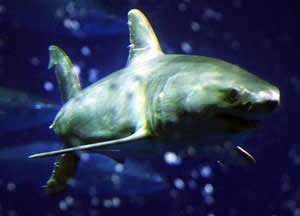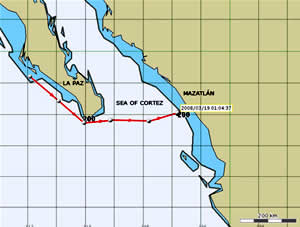
The great white shark released from Monterey Bay Aquarium has traveled from the southern tip of Baja California toward waters off the Mexican coast.

Map of the shark's travels
A young white shark returned to the wild by the Monterey Bay Aquarium six weeks ago has traveled past the southern tip of Baja California and is heading toward waters off the Mexican mainland, according to data from an electronic tracking tag the shark is carrying.
The tag is delivering near real-time information on his position – information the public can track online, where his movements are updated and mapped almost on a daily basis.
The male shark, released on February 5 after 162 days at the aquarium, is the first shark released from the Outer Bay exhibit to carry two different tracking tags. All three white sharks exhibited at the aquarium since 2004 have survived and thrived following their release.
As with the two previous sharks, he carries one tag that logs where he travels, including the water temperatures and depths he favors. That tag is programmed to pop free on July 2, when it will transmit its stored data via Argos satellite to researchers at the aquarium and at Stanford University's Hopkins Marine Station in Pacific Grove. Stanford is the aquarium's lead partner in the white shark research project.
The second tag – deployed for the first time on a shark released from the aquarium – is a Smart Position-Only Tag (SPOT) that transmits the shark's location via satellite when its dorsal fin breaks the surface of the water. The tag reports in every two days.
An updated map of its movements is posted on the Tagging of Pacific Predators (TOPP) website, www.topp.org, by following the Juvenile White Shark link on the Live Data page.
TOPP is one of 17 projects of the Census of Marine Life, an ambitious 10-year, 80-nation endeavor to assess and explain the diversity and abundance of life in the oceans. Several dozen TOPP researchers from eight countries are using satellite tags to track 22 different species of top predators that roam the Pacific Ocean – including white sharks.
The SPOT readings confirm that the white shark made it safely past fishing grounds on the Pacific coast of California and the Baja Peninsula, rounded Cabo San Lucas and is heading toward the Mexican mainland barely 40 days after his return to the wild.
A pop-up tag placed on a female white shark released in 2005 tracked her from Monterey Bay to waters north of Santa Barbara during her first 30 days back in the wild. The second shark reached Cabo San Lucas 90 days after his release in 2007.
For the third shark, the tag is programmed to separate 148 days after release and the shark was fitted with a SPOT tag as well. Both decisions were based on a desire to learn more about where young white sharks travel, said Randy Hamilton, vice president of husbandry for the aquarium.
"It's remarkable," Hamilton said. "The shark made it to Cabo in one-third the time it took the second animal to get there. To travel that far, that fast was totally unexpected. It's another reminder of just how little we know about what these animals do in the wild."
The pop-up tag will collect data for another three months, and the SPOT will keep reporting for several months beyond that, he said.
"Where will this shark end up?" he asked. "Will it turn north into the Gulf of California? It's anybody's guess. What we're learning adds tremendously to what little is known about the lives of young white sharks."
The learning process is also a bit harrowing, Hamilton said, because the waters through which the young shark has passed are prime fishing grounds for sharks and other species.
The young shark was seen by more than 650,000 people during his 162 days on exhibit. That was about 8 percent more visitors than aquarium officials had anticipated, and slightly below attendance levels for the prior year.
The shark was caught accidentally on August 4, 2007 off Ventura by a commercial fisherman, and kept under observation for 24 days in a 4-million-gallon ocean pen off Malibu. Aquarium staff determined that he was feeding and navigating well in the pen before they decided to bring him to Monterey.
Since 2002, through its White Shark Research Project, the aquarium has studied young white sharks in the wild and brought three white sharks to Monterey for exhibit. During that time, the aquarium and its research partners have tagged and tracked 12 juvenile white sharks off Southern California.
Much of the tagging in Southern California is done in collaboration with a rapid response team headed by Dr. Chris Lowe with the Shark Lab at California State University-Long Beach, and Dr. Chuck Winkler with the Southern California Marine Institute.
The aquarium has allocated more than $1 million to white shark field research since 2002, with much of the money supporting the tagging of adult white sharks off the Farallon Islands and Point Año Nuevo. Shark researchers with the Tagging of Pacific Predators, led by Dr. Barbara Block and her colleagues at Stanford University's Hopkins Marine Station, have fitted 143 adult white sharks with data-collecting tags in Central Coast waters.
Information gleaned when the tags report back has provided new insights into the far-ranging travels of white sharks in the eastern Pacific, according to Dr. Block, a marine biologist and principal investigator with TOPP.
The aquarium will begin its seventh field season of white shark research this summer, and will again attempt to bring a young shark back to Monterey for exhibit.
Each of the three white sharks brought to Monterey has been "a powerful emissary for ocean conservation," said aquarium Executive Director Julie Packard. Surveys of aquarium visitors who saw the first white shark found many of them reporting that they came away from the experience with a deeper understanding of the need to protect white sharks and their ocean homes.
